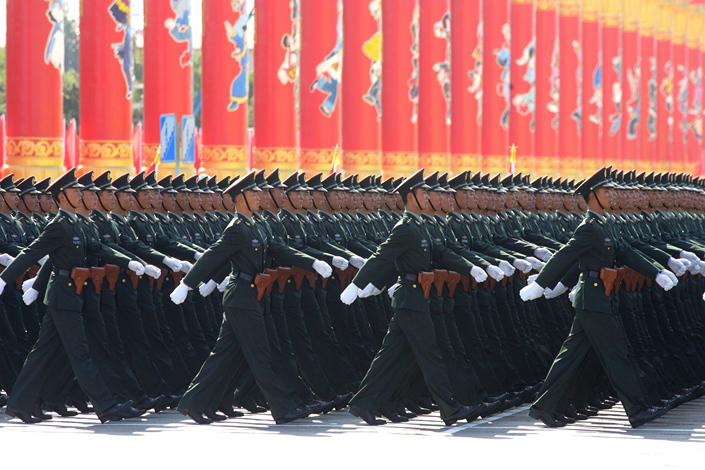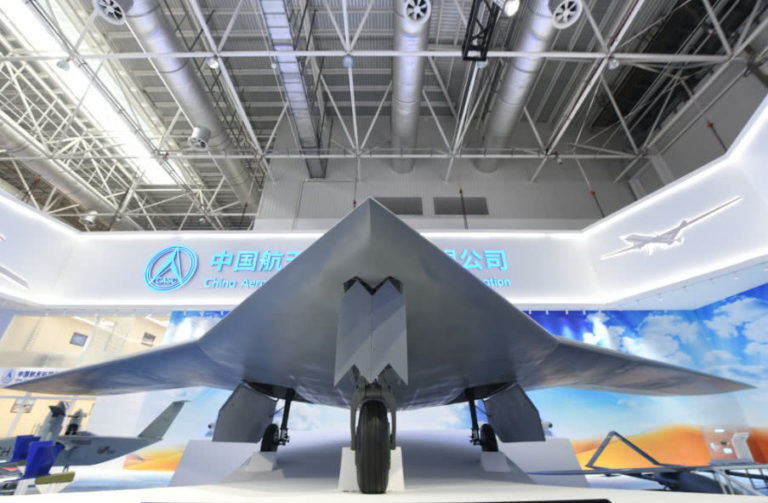[Continuing from last post]
The CCP regime maintains the largest regular army in the world, with two million active military personnel. The People’s Liberation Army also has the largest ground force in the world, the largest number of warships, the third-most naval tonnage, and a massive air force. It has a trinity nuclear strike capability consisting of intercontinental ballistic missiles, ballistic-missile submarines, and strategic bombers.
The Chinese regime also has 1.7 million armed police personnel, which are under the unified leadership of the CCP Central Military Commission, and a large number of reserve and militia units. The Party’s military doctrine has always stressed the importance of “people’s war.” Under the CCP’s totalitarian system, it can quickly impress all available resources to military use. This means that the CCP has a pool of over a billion people (including overseas Chinese) from which it can draft huge numbers of people into militia service.
China’s GDP increased rapidly between 1997 and 2007. The CCP relies on economic power to rapidly expand armaments production and upgrade its arsenal. It is estimated that by 2020, the PLA ground forces will have five thousand modern main battle tanks. The PLAN will have at least two aircraft carriers in its fleet. Ninety percent of PLA Air Force fighters are of the fourth generation, and China has begun to introduce fifth-generation fighters.
In early 2017, China announced a 6.5 percent inflation-adjusted increase in its annual military budget to US$154.3 billion. Analysis of data from 2008 through 2017 indicates China’s official military budget grew at an annual average of 8 percent in inflation-adjusted terms over that period. [113] Observers estimate that the actual military spending of the CCP is twice as much as what is officially acknowledged. Aside from this, the military strength of the regime is not fully reflected in military spending because its actual military expenditure is higher than the public figures, and the CCP can requisition many civilian resources and manpower at its discretion. The entire industrial system can serve the needs of war, which means its true military capabilities far exceed official data and the usual estimates.
The CCP will build a global system consisting of more than thirty Beidou (Big Dipper) navigation satellites by the end of 2020, with global GPS military positioning capabilities. The mass production of the Rainbow series of military drones serves more tactical considerations for the CCP. For example, in the Taiwan Strait layout, the CCP may gain advantages through its unmanned aircraft machine-sea tactics. [114] A large number of aerial drones can form clusters under the control of satellites and artificial intelligence, making them useful in regional and asymmetrical conflicts.
The stealth fighter Chinese J-20, which was unveiled at the Zhuhai Air Show, resembles the American F-22, while the Chinese J-31 appears modeled on the F-35. The PLA is closing the gap with the United States in the development of modern jet fighters.
In addition, the CCP uses a broad range of espionage to catch up with the United States in technology. According to some recent estimates, more than 90 percent of espionage against the United States conducted via hacking comes from China, and the CCP’s networks infiltrate large American companies and the military, stealing technology and knowledge that the Chinese cannot develop independently. [115] China’s drone technology was stolen from the United States.
In terms of tactics, the PLA is keen on asymmetric capabilities: asymmetric warfare, asymmetric strategy, and asymmetric weapons. [116] Adm. Philip S. Davidson, the new commander of the Indo-Pacific Command, described China as a “peer competitor.” He said that China is not trying to match America’s firepower at a one-to-one ratio; rather, it is trying catch up with the United States by building critical asymmetric capabilities, including the use of anti-ship missiles and capabilities in submarine warfare. He warned that “there is no guarantee that the United States would win a future conflict with China.” [117]
The CCP relied on its research and development of Dongfeng 21D missiles (anti-ship ballistic missiles for use against U.S. aircraft carriers) to conduct similar sniper-mode confrontation. In 2018, the CCP publicly exhibited the land-based Eagle-Attack-12B supersonic anti-ship missile, known as the “aircraft carrier killer.” It has drawn a 550-kilometer “death zone” in the western Pacific, in which American carrier battle groups will be susceptible to ultra low-altitude saturation strikes. These missiles become an important military means of the PLA’s regional denial operations aimed at preventing U.S. military intervention.
Following the rapid expansion of its military power, the CCP regime has become a huge weapons exporter to the world’s authoritarian regimes, such as North Korea and the rogue regimes of the Middle East. On the one hand, the goal is to expand its military alliances, and on the other hand, to disperse and counter U.S. military power. The CCP regime spreads and encourages anti-American sentiment and hatred. It is easy for the CCP to unite with other anti-American regimes to further its hegemonic ambitions.
At the same time, the CCP leadership advocates terrorist military theories such as the aforementioned unrestricted warfare. It advocates the necessity of war by saying that “war is not far from us, it is the birthplace of the Chinese century.” It legitimizes violence and terror with words such as “The dead are the driving force for the advancement of history.” It justifies aggression: “There is no right to development without the right to war,” and “the development of one country poses a threat to another — this is the general rule of world history.” [118]
Zhu Chenghu, dean of the Defense College of the National Defense University of the People’s Republic of China, publicly stated that if the United States intervenes in a war in the Taiwan Strait, China will preemptively use nuclear weapons to raze hundreds of cities in the United States, even if all of China to the east of Xi’an (a city located at the western edge of China’s traditional boundaries) were destroyed as a consequence. [119] Zhu’s statements were a public display of the CCP’s ambitions and a means of probing reactions by the international community.
It is important to be aware of the fact that the CCP’s military strategies are always subordinate to its political needs, and that the regime’s military ambitions are only a small part of its overall schemes. The Party’s approach is to rely on both economic and military means to impose its communist ideology on the rest of the world. [120]
From Chapter Eighteen
The Chinese Communist Party’s Global Ambitions

CCP Military Parade

CCP unveiled CH-7 Stealth Combat Drone

